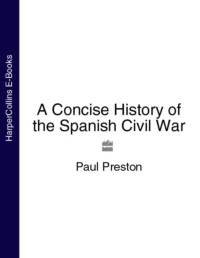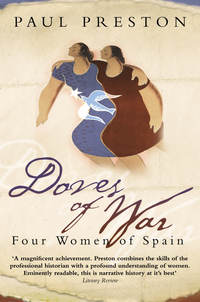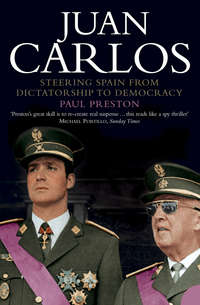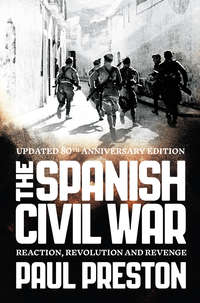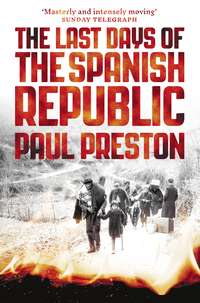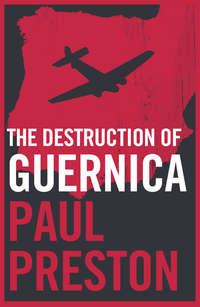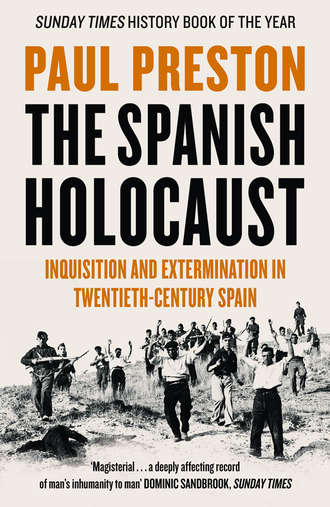
Полная версия
The Spanish Holocaust: Inquisition and Extermination in Twentieth-Century Spain
In January 1935, Giménez Fernández’s Law on Access to Ownership offered tenants the chance to buy land they had worked for twelve years. Mild as it was, the project provoked a parliamentary coalition of ultra-rightist deputies, led by the Carlist José María Lamamié de Clairac (Salamanca) and four CEDA deputies, Mateo Azpeitia Esteban (Zaragoza province), Cándido Casanueva y Gorjón (Salamanca), Luis Alarcón de la Lastra (Seville province) and, most ferociously of all, Rodríguez Jurado. They were virulent in their hostility to the idea of peasants being given access to property.21
Luis Alarcón de la Lastra was an artillery officer and Africanista who had left the army rather than take the oath of loyalty to the Republic. He was also an aristocrat, holding the titles of Conde de Gálvez and Marqués de Rende, and owned considerable property around Carmona, the area of Seville province with one of the greatest concentrations of large estates. He had become a CEDA deputy for Seville in 1933 but failed to gain a seat in the February 1936 elections. He would rejoin the army at the beginning of the Spanish Civil War and serve in Yagüe’s African columns commanding the artillery that bombarded numerous towns. By 1938, he was commander of the artillery of the Moroccan Army Corps. At the end of March 1939, Franco rewarded him by naming him Civil Governor of Madrid and five months later Minister of Industry and Commerce.22
Now, in session after session in the Cortes, Alarcón, Lamamié and the CEDA ultras stripped away the progressive features of Giménez Fernández’s law on rural leases and added clauses that permitted a spate of evictions. Gil Robles stated that only concessions made in a Christian spirit could prevent the revolution, yet stood back and watched his Minister being called a ‘white bolshevik’ and ‘a Marxist in disguise’. Moreover, Gil Robles placed Giménez Fernández’s fiercest enemies on the parliamentary committee examining the drafts of his laws. Lamamié de Clairac showed just how far his Catholic faith went when he declared that ‘if the Minister of Agriculture goes on quoting Papal Encyclicals in support of his projects, I can assure him that we will end up becoming Greek orthodox’.23 When he next provoked a cabinet crisis, Gil Robles quietly dropped Giménez Fernández.
On 3 July 1935, Giménez Fernández’s successor, Nicasio Velayos Velayos, a conservative member of the Agrarian Party from Ávila, presented what came to be known as the ‘agrarian counter-reform’. It was so reactionary that it was denounced by José Antonio Primo de Rivera as well as by various Left Republicans and Radicals. Its most dramatic change was to drop the Inventory of Expropriable Property. This permitted landowners to avoid expropriation by putting their properties in other names. Henceforth, only those who wanted their property compulsorily purchased had to undergo expropriation. Moreover, compensation would be decided case by case by tribunals consisting of landowners, who would ensure that it would be at full market value.24 In Extremadura, the local landowners began to evict the yunteros. In the village of Fregenal de la Sierra in Badajoz, one landowner alone evicted twenty families.25
The consequent level of social tension in Badajoz was starkly revealed on 10 June 1935 when the twenty-six-year-old Socialist deputy for the province, Pedro Rubio Heredia, was shot dead in a restaurant by Regino Valencia, who worked for Salazar Alonso. It will be recalled that Regino Valencia had carried out the ‘inspection’ which led to the removal of José González Barrero as Mayor of Zafra. Rubio’s funeral was attended by thousands of members of the FNTT. At Valencia’s trial, on 27 June, he was defended by Manuel Baca Mateos, a CEDA deputy for Seville, who claimed that the death had come about as a result of a fight. The Socialist Juan-Simeón Vidarte, acting for the victim’s family, proved to the satisfaction of the court that the attack had been unprovoked. Valencia was sentenced to twelve years and a day in prison. He then appealed to the Supreme Court, where he was defended by Rafael Salazar Alonso in person. Vidarte wrote later: ‘knowing as I and the entire province did, that he [Salazar Alonso] was behind the murder, this hard-faced cheek shocked and disgusted me’. At the unsuccessful appeal at the end of December 1935, there was uproar when Vidarte said that Salazar Alonso should have been wearing not lawyer’s robes but convict’s overalls.26
Despite being made Mayor of Madrid, Salazar Alonso’s political fortunes had plummeted since his removal from the Ministry of the Interior at the beginning of October 1934. Aware that the inclusion of three CEDA ministers in his cabinet would provoke fury on the left, Lerroux felt that he could not keep Salazar Alonso on. It was a gesture to secure President Alcalá Zamora’s approval for the new cabinet.27 In the parliamentary debate on the revolutionary events in Asturias and Catalonia and their subsequent repression, the ex-Prime Minister Ricardo Samper declared that responsibility for what had happened lay with Salazar Alonso. Utterly mortified, Salazar Alonso got up and walked out of the Cortes.28
Given that both in his private letters to Amparo and in his memoirs, Salazar Alonso boasted of provoking the workers’ uprising, his distress can have derived only from the fact that all had not turned out as well as he had hoped. The post-October repression brought a semblance of social peace, but violence was not far from the surface. The south was badly hit by drought in 1935, unemployment rose to more than 40 per cent in some places and beggars thronged the streets of the towns. The hungry agricultural labourers and the well-to-do rural middle and upper classes regarded each other with fear and resentment. The right-wing campaign for the elections of February 1936 prophesied that a left-wing victory would mean ‘uncontrolled looting and the common ownership of women’. Even without such apocalyptic provocation, natural disaster intensified social tension. After the prolonged drought of 1935, early 1936 brought fierce rainstorms that ruined the olive harvest and damaged wheat and barley crops. Across Andalusia and Extremadura, during the election campaign, the owners offered food and jobs to those who would vote for the right. To refuse could mean a beating or loss of work. In both urban and rural areas of unemployment, the local branches of Acción Popular began to open soup-kitchens and to distribute blankets to the poor. In many places, the right set out to buy votes.29
In most southern provinces, the Casas del Pueblo were still closed sixteen months after the October revolution. In Granada, for example, the Republican newspapers mysteriously disappeared en route from Granada to outlying towns and villages, while the CEDA paper Ideal always got through. Ideal called on right-wingers to abandon their ‘suicidal inertia’, recommending a few beatings to keep the left quiet. In many provinces, caciques hired thugs who, often with the assistance of the Civil Guard, prevented the dissemination of left-wing propaganda. Republican posters were ripped down at gunpoint; Republican orators were turned away from villages by roadblocks or simply arrested. Rumours were spread that the peasants could not vote unless they had special documentation.30
The atmosphere was captured with all its bitterness by Baldomero Díaz de Entresotos who was the land registrar in Puebla de Alcocer in the area in north-east Badajoz known as La Siberia Extremeña. Highly sympathetic to fascism, Díaz de Entresotos was affronted by the fact that a taxi firm in Castuera used second-hand cars to carry the local working class at reasonable prices. A landowner commented to him:
what we don’t need are elections and tolerance. It’s all well and good that we used to have such things when it was all kept between ourselves, just to decide whether liberals or conservatives or so-and-so or so-and-so would be in charge. But now, when it’s about law and order or revolution, we don’t need all this drivel about parliament and democracy. The answer here is to force this rabble to submit, by whatever means, if necessary cutting off their heads before they cut off ours.
One of Díaz de Entresotos’s close friends was a landowner, Alfonso Muñoz Lozano de Sosa, who was also an infantry lieutenant serving with the Assault Guards. On election day, 16 February, he came to Puebla de Alcocer with a machine-pistol. The village was also visited on that day by Ricardo Zabalza, the secretary general of the landworkers’ union, the FNTT, who was a Socialist candidate for Badajoz. Zabalza was eating alone at the local inn, with his head down, deeply aware of the hostility of his fellow middle-class customers. Díaz de Entresotos had lunch with Lieutenant Muñoz and wrote later of his visceral hatred of Zabalza (on the basis of this one sighting and without ever actually meeting him). Zabalza, a schoolmaster, was invariably neatly and cleanly dressed. However, such was Díaz de Entresotos’s paranoid loathing of the left that he saw only an abomination:
Zabalza looked just like what he was. Unkempt and repulsive, as befitted his damaging activities. He went around the villages advising riot and plunder. It was rumoured that, during the peasants’ strike of 1934, he had put a bomb on a railway line. I had no idea if this fact [sic] was true but, looking at this grim and dirty man, it seemed perfectly likely. How many times that day did I gaze on Muñoz’s machine-pistol, dwelling on the pleasure it would give me to open fire on that disgusting flesh!
When the election results began to come in, Muñoz commented ominously, ‘This has to be settled with bullets.’31 Their desire to see Zabalza dead would be satisfied four years later when he was executed by firing squad in a Francoist prison.32
The narrowness of the left-wing electoral victory reflected the polarization of Spanish society. The working masses, especially in the countryside, were in no mood for compromise after the so-called ‘two black years’ of vindictive right-wing government from 1933 to 1935. Both the rural and urban working classes demanded reparation for the post-October repression and the swift implementation of the reform programme elaborated by the leaders of the Popular Front electoral coalition. Considerable alarm ran through the middle classes when crowds gathered at prisons in Asturias and elsewhere calling for the release of those imprisoned after October 1934 and when groups of labourers presented themselves for work at the large estates. In many rural towns, there were attacks on the casinos (landowners’ clubs). In others, churches were burned in reprisal for their priests having justified the repression and using their pulpits for right-wing propaganda during the electoral campaign.
The new Prime Minister Manuel Azaña was horrified by the violence of popular agitation and rapidly embarked on a programme of conciliation. On 20 February 1936, his first cabinet meeting approved the return of the elected town councils and decreed an amnesty for those imprisoned after October 1934. The following day, Azaña made a radio broadcast to the nation in which he undertook to ‘heal the wounds caused in recent times’ and promised that his government would not seek revenge for the injustices of the last two years. He was confident that the popular ferment was a temporary phenomenon, fruit of the euphoria that accompanied the electoral victory. With a view to calming the agitation, on 29 February his cabinet issued a decree obliging employers to readmit workers sacked because of their ideology or for participating in strikes after 1 January 1934 and to compensate them with their pay for a minimum of thirty-nine days or a maximum of six months. The immediate reaction of a huge group of employers’ organizations was to issue a statement that this constituted a ‘true economic catastrophe’. In the short term, it appeared that the right in general expected from Azaña, as the dramatist Ramón del Valle Inclán put it, ‘what the sick expect from cod-liver oil’.33
However, Azaña faced debilitating problems. Despite his broadcast, the rural agitation continued. He was deeply depressed by news of events in Yecla in the north of Murcia, where seven churches, six houses and the property registry had been set alight.34 His ability to control the situation was severely undermined by the refusal of Francisco Largo Caballero to permit Socialist participation in the cabinet. Distrustful of Republican moderation, he had been prepared to support the electoral coalition only to secure political amnesty for the victims of the repression. Embittered by right-wing obstruction of reform between 1931 and 1933, Largo Caballero believed that only an exclusively Socialist cabinet could transform Spanish society. His overconfident view was that the Left Republicans should pursue their own programme and effectively exhaust themselves in carrying out the bourgeois stage of the revolution. They would then either make way for a Socialist cabinet or be engulfed by a fascist uprising which would itself trigger a successful revolution.
On 3 April 1936, Largo Caballero was interviewed by the American journalist Louis Fischer and he told him complacently: ‘The reactionaries can come back into office only through a coup d’état.’35 He was just mouthing revolutionary platitudes, but unfortunately the counterfeit nature of his revolutionary rhetoric was not perceived as such among the middle and upper classes. While their fears of revolution were intensified by right-wing propaganda, Largo Caballero’s policy prevented both revolution and strong government. It eventually ensured instead that an ineffectual Republican government would be in power while the military conspiracy was prepared.
The tension was such that Azaña felt obliged to calm things down. He wrote to his brother-in-law: ‘every night the left feared a military coup aimed at preventing communism. The right feared that the Soviet was on the horizon. I’ve never seen such panic or such a stupid situation. The Socialists have organized an intelligence system based on concierges, cleaners and chauffeurs, and they get all the below-stairs gossip.’ With the stock market falling and the streets deserted, on 3 April, Azaña made the first of only two major speeches to the new Cortes. In it, he mentioned the agitations and disturbances that had taken place in the countryside, stating that his cabinet had to deal with what he called ‘a national ulcer’.
Referring to the excesses of the first six weeks of his government, he asked: ‘can the masses, provoked and ill treated, those forced to starve for two years, those coming out of prison, be asked to behave, as we try to do, without resentment for the injustices which we remember only too well? We had to expect, and the Government did expect … that the first explosion of popular anger would see excesses that would undermine political authority and damage the Government.’ While condemning violent abuses, he also denounced those who sought to make political capital from them. He recognized that the tendency of Spaniards to resolve problems by violence engendered ‘a presumption of catastrophe’. ‘Many people are going around depressed,’ he declared, ‘imagining that Spain is going to wake up having been turned into a Soviet.’ While understanding how apolitical individuals might harbour such fears, he found it intolerable that the politically aware should foment panic in such a way as to create the atmosphere necessary for a coup d’état.
Azaña put the disorder into its proper context and went on to declare that his government aimed to remedy the disequilibrium at the heart of Spanish society. He acknowledged that this could mean harming the interests of those who benefited from ‘this horrendous imbalance’, adding that ‘we come to break up any abusive concentration of wealth wherever it may be’. While he did not expect an entire social class to commit suicide, he called on the wealthy to make sacrifices rather than face the consequences of the desperation provoked by social injustice. He ended prophetically, more so than he knew at the time, declaring that this was the last chance for the Republic because, if the redistribution of wealth he was advocating was opposed as the reforms of 1931–3 had been, then there would be no legal way forward. Astonishingly, the reaction to this ultimatum was widespread relief from the Communists to the extreme right. The stock market began to rise again and Azaña was regarded as a national hero.36
Although lacking Socialist participation, Azaña’s new government was determined to proceed rapidly with meaningful agrarian change. The task was rendered all the more difficult because of a rise in unemployment by the end of February 1936 to 843,872, or 17 per cent of the working population.37 The new Minister of Agriculture, Mariano Ruiz-Funes, announced his commitment to rapid agrarian reform. The resurgent landworkers’ union intended to make him keep his word. After the harsh rural repression of the previous two years, in 1936 the FNTT began to expand at a vertiginous rate. Its militant leadership was in no mood to tolerate delays from the government or obstruction from the big landowners.
Immediately after the elections, Ricardo Zabalza had written to Ruiz-Funes urging him to expedite the return of land to the leaseholders evicted in 1935 and to re-establish the mixed juries (arbitration committees) and the decree of obligatory cultivation. In a letter to the Minister of Labour, Enrique Ramos, Zabalza requested the introduction of a scheme for placing unemployed workers with landowners. A third letter, to Amós Salvador, Minister of the Interior, called for the disarming of the caciques. Seriously alarmed by the quantity of weapons held by landowners and their retainers, and by the support that they enjoyed from the Civil Guard, the FNTT soon called upon members to form militias to prevent a repetition of the persecution of 1934 and 1935. Before the Cortes opened in mid-March, peasant demonstrations all over Spain supported Zabalza’s requests.38 The FNTT’s demands were not revolutionary but they still constituted a major challenge to the balance of rural economic power. Moreover, the events of the previous two years had exacerbated rural class hatred to a point which made the peaceful introduction of the desired social legislation highly unlikely. The economic situation ensured that the reforms, which were essential to alleviate the misery of the landless peasants, could not be absorbed by the owners without a significant redistribution of rural wealth. Constant rain between December 1935 and March 1936 had seriously damaged the grain harvest and reduced the profit margins of growers large and small. This natural disaster simply reinforced the reluctance of owners and workers alike to be conciliatory.
Anticipating the FNTT’s demands, CEDA propaganda had predicted that left-wing electoral success would be the prelude to the most hair-raising social disasters. Thus defeat on 16 February implied that landed and religious interests could not be defended legally and only violence would suffice. The Chief of the General Staff, Francisco Franco, believed that a left-wing election victory was the first stage of a Comintern plan to take over Spain. He had been convinced by the bulletins that he received from the Geneva Entente Internationale contre la Troisième Internationale, bulletins which in turn drew on inflated reports from Mola’s crony, the corrupt policeman Mauricio Carlavilla. From the early hours of 17 February, Gil Robles had been working with Franco to have martial law declared to overthrow the results. They managed to get several garrisons to do so, but their efforts foundered when the Director General of the Civil Guard, Sebastián Pozas Perea, remained loyal to the Republic.
On 8 March, Franco and other senior generals met in Madrid to put in train the most extreme violence of all, a military coup. They agreed to make General Emilio Mola overall director of the conspiracy and Colonel Valentín Galarza Morante his liaison chief.39 This was hardly surprising. In May 1935, when Gil Robles had become Minister of War, he had appointed Franco Chief of the General Staff and they had quietly established Mola in a secluded office in the Ministry of War to prepare operational plans for the use of the colonial army against the left on mainland Spain.40 Mola was then made general in command of Melilla and shortly afterwards military commander of the entire Moroccan protectorate. Franco ensured that reliable reactionaries were posted to the command of many units in Morocco and in Spain itself. He boasted later that these officers were key pawns in the coup.41
In the meantime, Andalusia and Extremadura were facing bitter conflict because the landowners had flouted agreements on wages and working conditions and evicted the yunteros. After the elections, watched by seething rightists, joyful peasants paraded through the towns flying their union banners and red flags. The rural middle classes were appalled by such signs of popular jubilation and by attacks on casinos. Labour legislation began to be reinforced and, in the south, workers were ‘placed’ on uncultivated estates. Those imprisoned after the 1934 harvest strike and the October events were released and returned to their towns and villages, to the chagrin of the local Civil Guards who had arrested them. In Andalusian towns, demonstrators attacked right-wing centres and clubs.42
The announcement of Azaña’s decrees of 20 February 1936 had been greeted cautiously, but their implementation provoked howls of outrage. The right-wing mayors imposed in 1934 by Salazar Alonso were unceremoniously expelled from the town councils of Badajoz and the deposed Socialists reinstated. Moreover, Salazar Alonso himself, the erstwhile champion of the Badajoz latifundistas, was a ruined man. In 1934, he had been heavily involved in the gambling fraud which eventually destroyed the Radical Party. He was one of several prominent Radicals who took bribes to help legalize the use of a rigged roulette wheel in Spanish casinos. The scandal that ensued in 1935 was called ‘Estraperlo’, from the names of the machine’s inventors, Strauss and Perlowitz. Salazar Alonso had been given a gold watch and 100,000 pesetas (about £35,000 in present-day values), and both his under-secretary at the Minister of the Interior, Eduardo Benzo, and the Director General of Security, José Valdivia, were paid 50,000 pesetas. Despite authorizing the use of the roulette wheel, Salazar Alonso, regarding the bribe as insufficient, arranged for a police raid when it was inaugurated at the San Sebastián casino. To get their revenge, the inventors leaked documents on the case to President Alcalá Zamora. In October 1935 in the subsequent parliamentary debate, Salazar Alonso was exonerated by 140 votes to 137, thanks to the support of the CEDA. When this was announced, José Antonio Primo de Rivera shouted, ‘¡Viva el Estraperlo!’43 Although he was still Mayor of Madrid, Salazar Alonso’s political career was over. During the February 1936 election campaign, his speeches in Badajoz were interrupted by shouted witticisms about roulette wheels and gold watches. He was defeated and immediately claimed that the results had been falsified. He told Lerroux that he had serious financial problems (despite receiving his full ministerial salary, as did all ex-ministers). He became president of the right-wing newspaper Informaciones in April 1936.44 In the early days of the Civil War, he went into hiding, was eventually arrested, summarily tried by a people’s tribunal and shot.
Feeling vulnerable, the richest local landowners abandoned their mansions. Throughout the entire south, Republican agrarian legislation was being revived. Mixed juries returned and obligatory cultivation of fallow land was reimposed. A variant of the legislation on municipal boundaries was activated, thereby preventing the local landowners from bringing in cheap outside labour to break union action. In many villages, the restored town councils decreed that municipal employees should be given back-pay to the date when they had been deposed. Workers were assigned to estates whose owners were expected to pay them. Needless to say, the possessing classes were outraged by the perceived injustice of such measures and by the impertinence of those that they expected to be subservient and respectful. Tension was exacerbated in some villages by mayors who prohibited traditional religious processions.45


